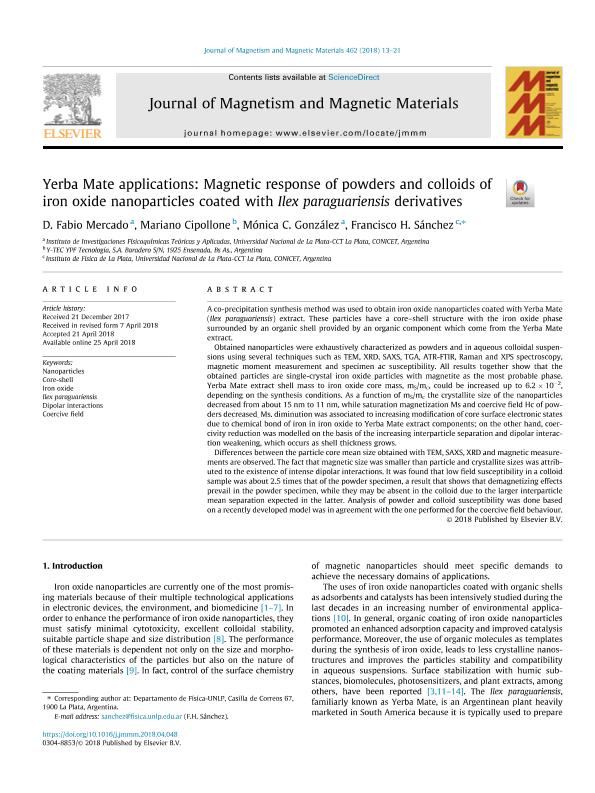Mostrar el registro sencillo del ítem
dc.contributor.author
Mercado Castro, Donaldo Fabio

dc.contributor.author
Cipollone, Mariano Enrique

dc.contributor.author
González, Mónica C.
dc.contributor.author
Sánchez, Francisco Homero

dc.date.available
2020-03-17T19:22:19Z
dc.date.issued
2018-09
dc.identifier.citation
Mercado Castro, Donaldo Fabio; Cipollone, Mariano Enrique; González, Mónica C.; Sánchez, Francisco Homero; Yerba Mate applications: Magnetic response of powders and colloids of iron oxide nanoparticles coated with Ilex paraguariensis derivatives; Elsevier Science; Journal of Magnetism and Magnetic Materials; 462; 9-2018; 13-21
dc.identifier.issn
0304-8853
dc.identifier.uri
http://hdl.handle.net/11336/99890
dc.description.abstract
A co-precipitation synthesis method was used to obtain iron oxide nanoparticles coated with Yerba Mate (Ilex paraguariensis) extract. These particles have a core–shell structure with the iron oxide phase surrounded by an organic shell provided by an organic component which come from the Yerba Mate extract. Obtained nanoparticles were exhaustively characterized as powders and in aqueous colloidal suspensions using several techniques such as TEM, XRD, SAXS, TGA, ATR-FTIR, Raman and XPS spectroscopy, magnetic moment measurement and specimen ac susceptibility. All results together show that the obtained particles are single-crystal iron oxide particles with magnetite as the most probable phase. Yerba Mate extract shell mass to iron oxide core mass, mS/mc, could be increased up to 6.2 × 10−2, depending on the synthesis conditions. As a function of mS/mc the crystallite size of the nanoparticles decreased from about 15 nm to 11 nm, while saturation magnetization Ms and coercive field Hc of powders decreased. Ms. diminution was associated to increasing modification of core surface electronic states due to chemical bond of iron in iron oxide to Yerba Mate extract components; on the other hand, coercivity reduction was modelled on the basis of the increasing interparticle separation and dipolar interaction weakening, which occurs as shell thickness grows. Differences between the particle core mean size obtained with TEM, SAXS, XRD and magnetic measurements are observed. The fact that magnetic size was smaller than particle and crystallite sizes was attributed to the existence of intense dipolar interactions. It was found that low field susceptibility in a colloid sample was about 2.5 times that of the powder specimen, a result that shows that demagnetizing effects prevail in the powder specimen, while they may be absent in the colloid due to the larger interparticle mean separation expected in the latter. Analysis of powder and colloid susceptibility was done based on a recently developed model was in agreement with the one performed for the coercive field behaviour.
dc.format
application/pdf
dc.language.iso
eng
dc.publisher
Elsevier Science

dc.rights
info:eu-repo/semantics/openAccess
dc.rights.uri
https://creativecommons.org/licenses/by-nc-sa/2.5/ar/
dc.subject
COERCIVE FIELD
dc.subject
CORE-SHELL
dc.subject
DIPOLAR INTERACTIONS
dc.subject
ILEX PARAGUARIENSIS
dc.subject
IRON OXIDE
dc.subject
NANOPARTICLES
dc.subject.classification
Física de los Materiales Condensados

dc.subject.classification
Ciencias Físicas

dc.subject.classification
CIENCIAS NATURALES Y EXACTAS

dc.title
Yerba Mate applications: Magnetic response of powders and colloids of iron oxide nanoparticles coated with Ilex paraguariensis derivatives
dc.type
info:eu-repo/semantics/article
dc.type
info:ar-repo/semantics/artículo
dc.type
info:eu-repo/semantics/publishedVersion
dc.date.updated
2020-02-10T14:05:45Z
dc.journal.volume
462
dc.journal.pagination
13-21
dc.journal.pais
Países Bajos

dc.journal.ciudad
Amsterdam
dc.description.fil
Fil: Mercado Castro, Donaldo Fabio. Consejo Nacional de Investigaciones Científicas y Técnicas. Centro Científico Tecnológico Conicet - La Plata. Instituto de Investigaciones Fisicoquímicas Teóricas y Aplicadas. Universidad Nacional de La Plata. Facultad de Ciencias Exactas. Instituto de Investigaciones Fisicoquímicas Teóricas y Aplicadas; Argentina
dc.description.fil
Fil: Cipollone, Mariano Enrique. YPF - Tecnología; Argentina
dc.description.fil
Fil: González, Mónica C.. Consejo Nacional de Investigaciones Científicas y Técnicas. Centro Científico Tecnológico Conicet - La Plata. Instituto de Investigaciones Fisicoquímicas Teóricas y Aplicadas. Universidad Nacional de La Plata. Facultad de Ciencias Exactas. Instituto de Investigaciones Fisicoquímicas Teóricas y Aplicadas; Argentina
dc.description.fil
Fil: Sánchez, Francisco Homero. Consejo Nacional de Investigaciones Científicas y Técnicas. Centro Científico Tecnológico Conicet - La Plata. Instituto de Física La Plata. Universidad Nacional de La Plata. Facultad de Ciencias Exactas. Instituto de Física La Plata; Argentina
dc.journal.title
Journal of Magnetism and Magnetic Materials

dc.relation.alternativeid
info:eu-repo/semantics/altIdentifier/url/https://www.sciencedirect.com/science/article/abs/pii/S0304885317339379
dc.relation.alternativeid
info:eu-repo/semantics/altIdentifier/doi/http://dx.doi.org/10.1016/j.jmmm.2018.04.048
Archivos asociados
